Continental Currency
July 22, 1776
An emission totaling $5,000,000 payable in Spanish milled dollars, or the equivalent in gold or silver, was authorized by the Continental Congress resolutions of July 22 and August 13th, 1776. The issue is similar to that of the November 29, 1775 issue except there was no $1 denomination. Apparently this was to be replaced by the Continental Currency coin. It was replaced by a $30 bill similar to that of May 10, 1775. Printed by Hall and Sellers in Philadelphia. The paper, made at Ivy Mills in Chester County, Pennsylvania, contained blue fibers and mica flakes. Detector bills were printed on blue paper. Denominations include the: $2, $3, $4, $5, $6, $7, $8 and $30.obv
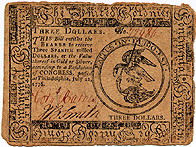 rev
rev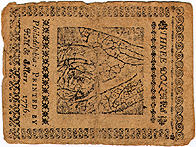
$3 Serial Number: 72,986 CC 07/22/76
Signers: Cornelius Barnes (in red), Jonathan Bayard Smith.
Size: 73 x 97mm (front border design: 70 x 92mm; back border design: 68 x 88mm).
Comments: Numbereing and first signature in red ink, the second signature in brown ink. J.B. Smith was a mamber of the Continental Congress. The emblem on the front (40mm) depicts an eagle fighting a heron with the motto "Exitus in dubio est" (The outcome is in doubt). On the back is a nature print of skeletonized elm and maple fruit as previously found on Pennsylvania currency. The paper contains blue thread and mica flakes.
Provenance: Purchased through the Robert H. Gore, Jr. Numismatic Endowment from the collection of William Warne of Harvey Cedars, NJ on 5/1/98.
obv
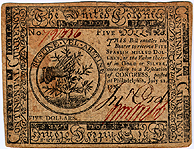 rev
rev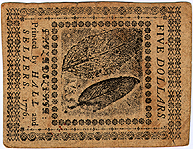
$5 Serial Number: 72,336 CC 07/22/76
Signers: John Ord, William Webb (in red).
Size: 75 x 96mm (front border design: 70 x 93mm; back border design: 68 x 88mm).
Comments: Numbereing and second signature in red ink, the first signature in brown ink. The emblem on the front (39mm) shows a bleeding hand in a thorn bush with the motto: SUSTINE VEL ABSTINE. The B is an H modified to from a letter B. This is the most difficult emblem in the series to understand. Benjamin Franklin explained the Continental Currency emblems in a letter published under the pseudonym of Clericus in the Pennsylvania Gazette of September 20, 1775. For the five dollar emblem he explained:
...we have a thorny bush, which a hand seems attempting to eradicate. The hand appears to bleed, as pricked by spines. The motto is, SUSTINE VEL ABSTINE; which may be rendered, Bear with me, or let me alone; or thus, Either support or leave me. The bush I suppose to mean America, the bleeding hand Britain. Would to God that bleeding were stopt, the wounds of that hand healed, and its future operations directed by wisdom and equity; so shall the hawthorn flourish, and form an hedge around it, annoying with her thorns only its invading enemies. [B. Franklin, Writings, ed. by J.A. Leo Lemay, 1987, pp. 734-738 on p. 735.The nature print on the back is of betony and sage. The paper contains blue threads and mica flakes.
Provenance: Purchased through the Robert H. Gore, Jr. Numismatic Endowment from the collection of William Warne of Harvey Cedars, NJ on 5/1/98.
obv
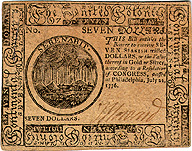 rev
rev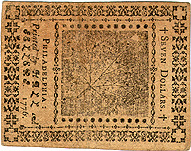
$7 Serial Number: faded CC 07/22/76
Signers: John Howard [first signature faded].
Size: 72 x 93mm (front border design: 70 x 91mm; back border design: 67 x 89mm).
Comments: Numbered and first signature in a light red ink that has faded. The emblem on the front shows a storm at sea with the motto: "Serenabit" (It will clear up). The nature print on the back is of buttercup. Paper contains blue threads and mica flakes.
Provenance: EANA mail bid auction 1/13/96 lot 289. Purchased through the Robert H. Gore, Jr. Numismatic Endowment.
obv
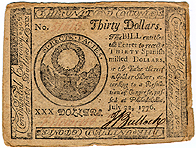 rev
rev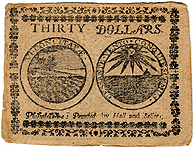
$30 Serial Number: 51,613 (faded) CC 07/22/76
Signers: John Howard (faded red ink), Joseph Bullock.
Size: 77 x 100mm (front border design: 70 x 93mm; back border design: 69 x 90mm).
Comments: The numbereing and first signature are in a faded red ink, the second signature is in a brown ink. The emblem on the front (40mm) shows a wreath on a tomb with the motto: "Si recte facies" (If you act righteously). On the back are two emblems: the emblem on the left (40mm) shows a strong wind creating waves and bears the motto: "Vi concitate" (Driven by force); the emblem on the right (39mm) shows the sun shining on sailing ships in a calm sea and bears the motto: "Cessante vento conquiescemus" (When the storm dies down we will rest). The paper contains blue thread and mica flakes.
Provenance: Purchased through the Robert H. Gore, Jr. Numismatic Endowment from the collection of William Warne of Harvey Cedars, NJ on 5/1/98.